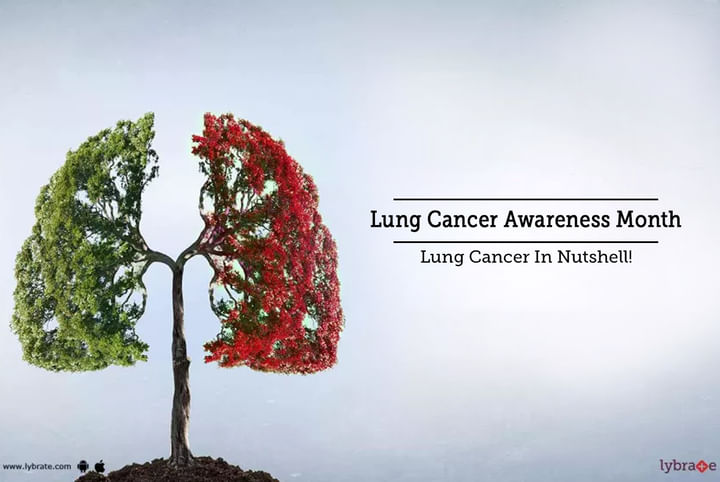Lung Cancer Awareness Month - Lung Cancer In Nutshell!
Cancer like most other diseases has the best rates of recovery with early detection and intervention. As there are no regular health screenings for blood cancer, only the awareness about the early warning signs can save your life. November is designated as the Lung Cancer Awareness Month, to ensure every individual is equipped to fight against lung cancer right from the start. Here are 4 vital facts you must know to win your fight against blood cancer.
Lung cancer is also known as pulmonary carcinoma or cancer of the lung. It occurs when DNA mutations develop in the cells/ tissues of the lungs leading up to uncontrolled growth in the tissues of the lung. By far, it is known to be the most common cancer in Asia.
1. Type: lung cancers can present as one of the following types:
- Non-Small Cell Lung Cancer (NSCLC): Most common type of lung cancer and constitutes nearly 85% of all lung cancers. The sub-types of NSCLC are as follows:
- Large cell carcinoma
- Squamous cell carcinoma (SqCC) (Epidermoid)
- Adenocarcinoma – accounts for majority of the NSCLC.
- Small Cell Lung Cancer (SCLC): It is also known as oat meal cancer and tends to spread (metastasize) quickly. This constitutes about 15% of the lung cancers.
- Mesothelioma: It is a rare cancer that develops in the mesothelial cells of the pleural or peritoneal surfaces. It usually arises in the pleural membrane lining the lungs, known as pleural mesothelioma. One that arises from the peritoneum is called the peritoneal mesothelioma and the one that arises from the pericardium is known as pericardial mesothelioma. Lastly, it can also arise from the tunica vaginalis known as testicular mesothelioma. People working with or prior exposure to asbestos are mostly at risk of developing mesothelioma. The latency period between time of exposure and development of mesothelioma can be somewhere between 20 to 40 years. Maximum of the patients who develop mesothelioma are men.
2. Gender: It affects the male populace predominantly. It is more common in men than in women and in those of lower economic status. However, the incidence of lung cancer, in women too, is on the rise of late.
3. Etiology: Cigarette/ Tobacco smoking remains the most important cause of lung cancer accounting for 85 – 90% of the cases. Incidence/ risk is proportionate to the number of cigarettes smoked irrespective of the age. Also, environmental toxins including smoke from burning black tar, exhaust gases from automobiles etc. too contribute actively to various lung diseases including cancer. People working in asbestos manufacturing factories who are exposed to asbestos dust are also likely to get lung cancer. Tuberculosis too is an additive risk factor. Again, people who have received ionizing radiation especially to treat Hodgkin Lymphoma or other malignancies also run the risk of developing lung cancer. Above-mentioned causes apart, genetic factors may also play a role.
4. Features: Lung cancer clinically presents in the following ways mainly. Signs & symptoms of malignant mesothelioma are as enumerated below
- Difficult/ labored breathing (Dyspnea)
- Chest pain
- Palpable chest wall mass
- Discordant chest wall expansion
- Weight loss (Cachexia)
- Loss of appetite (Anorexia)
- Night sweats
Signs & symptoms of non-small cell lung cancer (NSCLC) are as enumerated below. Majority of patients are symptomatic at diagnosis
- Chronic cough
- Difficult/ labored breathing (Dyspnea)
- Chest pain
- Blood stained sputum (Hemoptysis)
- Hoarseness
- Weight loss (Cachexia)
- Loss of appetite (Anorexia)
- Weakness
- Bone pain
- Pleural or pericardial effusion
- Superior vena cava syndrome
- Brachial plexopathy
- Neurologic pain
- Hypercalcemia of malignancy
Signs & symptoms of small cell lung cancer (SCLC) are as enumerated below
Symptoms as per the points 8 – 18 depicted above for NSCLC are applicable for SCLC as well. Additionally, patients suffering from SCLC may have:
- Fever associated with chest infections like bronchitis/ pneumonia that refuse to go away or keep coming back
- Horner syndrome
- Paraneoplastic syndromes including encephalitis/ sub-acute sensory neuropathy, hyponatremia, acromegaly, cancer associated retinopathy, ectopic corticotropic syndrome etc all.
5. Screening: is generally recommended for asymptomatic/ symptomatic populations as surveillance for high-risk individuals – who are either current or former smokers (quit smoking within the last 15 years) have at least a 30 pack-year smoking history and those who do not have any prior history of lung cancer. The goal of screening, as usual, is to be able to detect & diagnose lung cancer at an early stage which is potentially curable. It is mostly radiologic with a low dose helical computed tomography (CT) scan being more effective in detecting early-stage lung cancer than a chest radiograph can.
6. Diagnosis: Abnormal blood test results may be indicative of malignancy, but a follow-up imaging/ biopsy is always the gold standard for an accurate diagnosis. Following are the diagnostics employed mainly:
- Blood: Hb may be low, TLC, ESR and polymorphs increased. Adenocarcinomas are likely to express thyroid transcription factor 1 (TTF-1) or carcinoembryonic antigen (CEA). On the other hand, mesotheliomas are likely to express Wilms Tumor -1 (WT-1) protein and Calretinin.
- Imaging: Thoracoscopy, Bronchoscopy, X-Ray, CT Scan etc all. Positron Emission Tomography (PET) / CT scan and Magnetic Resonance Imaging (MRI) scan help detect metastasis if any.
- Biopsy: It clinches the histologic diagnosis and the nature of the disease.
7. Treatment: Conventional treatment includes surgery, chemotherapy and radiotherapy as contextually appropriate. Simultaneously, an adjunctive or integrative naturopathic treatment with suitable complementary & alternative medicines (CAM) too can help improve clinical outcomes and facilitate recovery as would be feasible contextually.
8. Prognosis: Preventive measures, earlier diagnosis and right early treatment are key for effective therapeutic management & better prognosis. Like most other cancers, the chances of cure for early-stage lung cancer are more. The cure/ recovery chances are influenced by the grade, stage of cancer, recurrence and the patient’s general health & vitality etc all. The primary determinant of prognosis in NSCLC is the stage at which the cancer is diagnosed. For non-metastatic cancers, however, it is the nodal status that determines the stage and hence the prognosis.
9. Prevention: Rightly said, prevention is always a better choice. Cigarette smoking is to be avoided by all means as it is the single major cause of lung cancer. Even exposure to cigarette smoke (passive or secondhand) is also an established cause of lung cancer and is known to increase the risk of lung cancer in non-smokers as well. Preventing exposure to secondhand smoke can be helpful in decreasing the incidence and mortality of primary lung cancers. Above-mentioned apart, other important risk factors such as exposure to ionizing radiation, environmental carcinogens like smoke from burning black tar, exhaust gases from automobiles, outdoor air pollution, and occupational exposure to asbestos, arsenic, beryllium, nickel, cadmium, chromium etc all too are known to increase the risk for lung cancer and mortality thereof. In fact, cigarette smoking is known to potentiate the effect and hence the lung cancer risk of many of the above-mentioned carcinogens, multi-fold, in smokers. Thus, either eliminating or reducing the exposure to the above-mentioned carcinogens can lead to a decrease in the risk of lung cancer and incidences thereof. Furthermore, randomized clinical trials indicate that high-intensity smokers (only) who take supplementation of beta-carotene have an increased risk/ incidence of lung cancer. Vitamin E supplementation, on the other hand, does not affect the risk of lung cancer as indicated by the trials.
In case you have a concern or query you can always consult an expert & get answers to your questions!



+1.svg)
